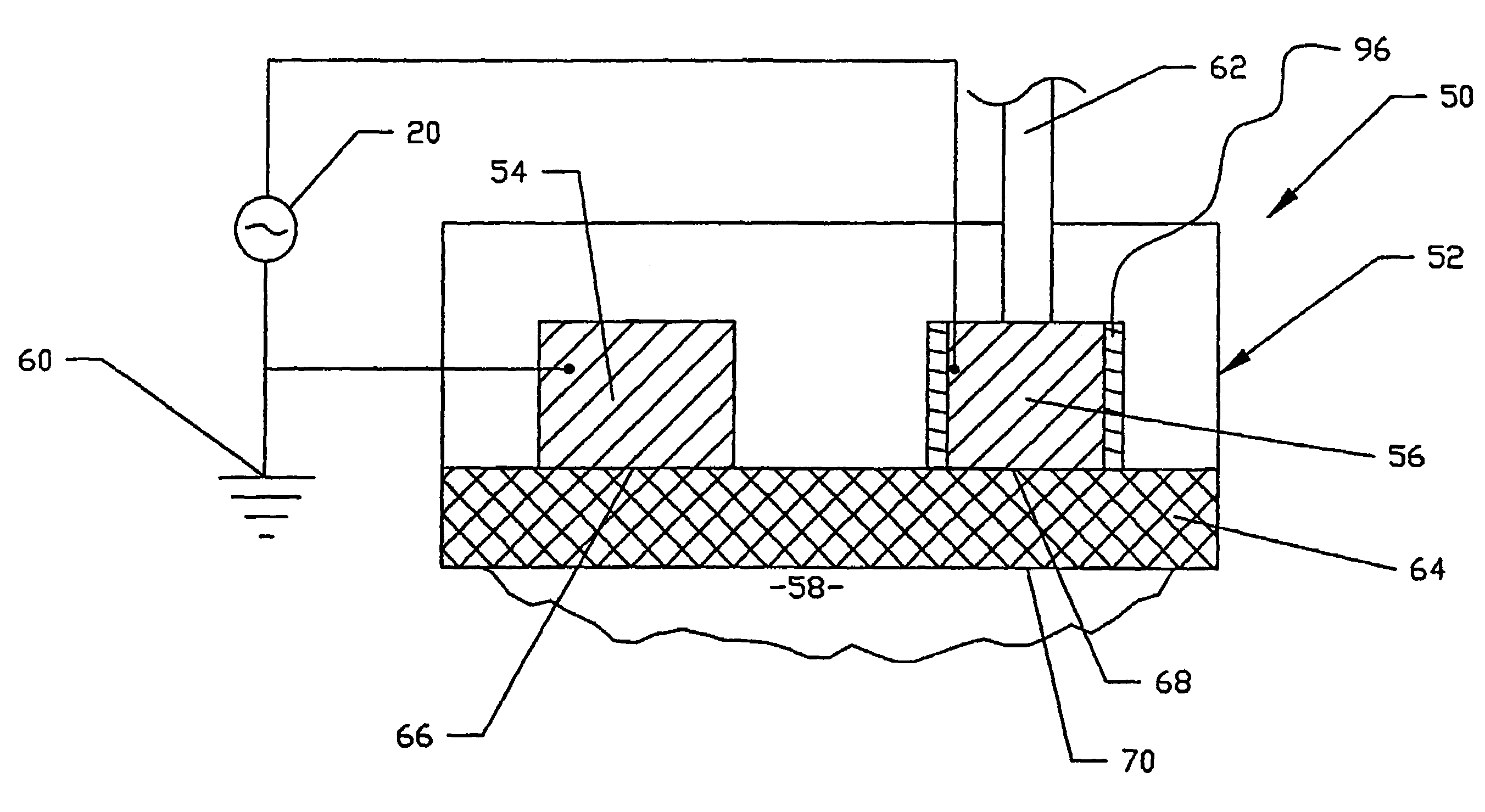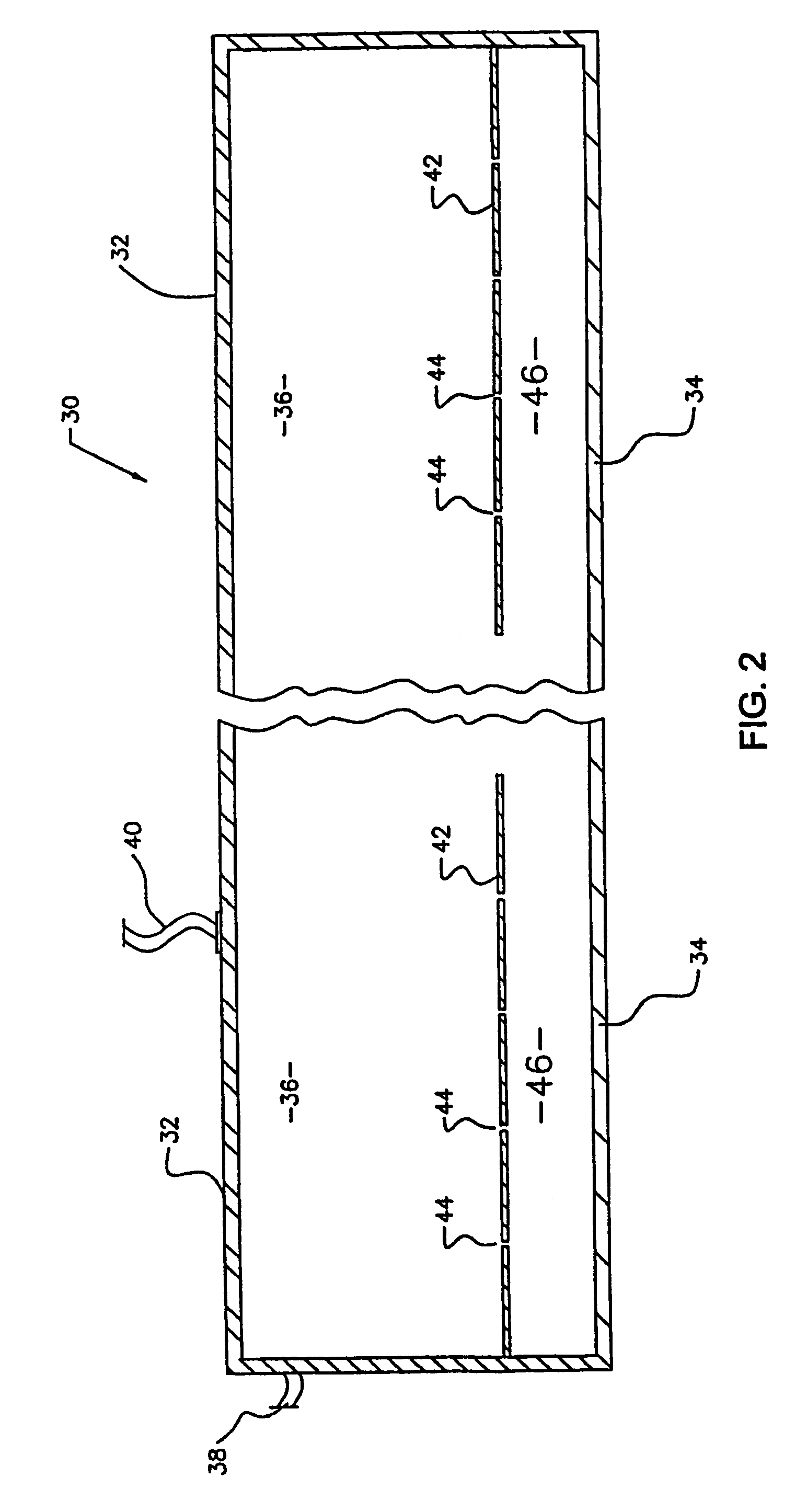Atmospheric glow discharge with concurrent coating deposition
a technology of atmospheric glow and coating deposition, applied in the field of barrier films, can solve the problems of increasing operating and maintenance costs, and achieve the effects of improving the barrier properties of moisture and oxygen, enhancing curing, and improving the quality of products
- Summary
- Abstract
- Description
- Claims
- Application Information
AI Technical Summary
Benefits of technology
Problems solved by technology
Method used
Image
Examples
example 1
Atmospheric Plasma Treatment with Vapor Deposition; UV-Light Curing
Substrate Material: PET Film Run at Line Speed of 200 ft / min
[0040]1. Atmospheric Plasma Treatment with Vapor Deposition. An atmospheric glow discharge was produced by feeding helium at 2000 sccm and an AC-voltage frequency of 20 KHz. Liquid fluoroacrylate monomer (with 5% Irgacure-184 photoinitiator) was evaporated at 200-250° C. and the vapor was mixed at a rate of 200 sccm with the plasma gas prior to injection, as shown in FIG. 5.
2. Curing. The condensed vapor was exposed to a Low-Pressure Mercury UV Lamp at 300 Watt / inch.
[0041]The resulting coated product exhibited hydrophobic and oleophobic properties with excellent adhesion to the substrate. Similar results were obtained when polypropylene, polyethylene, polycarbonate, polyamide, polyimide and cellulose derivative films were treated / coated according to Example 1. The same experiment was repeated with paper and fabrics (woven and nonwoven). Similar hydrophobicit...
example 2
Atmospheric Plasma Treatment; Valor Deposition; UV-Light Curing
Substrate Material: PET Film Run at Line Speed of 200 ft / min
[0042]1. Atmospheric Plasma Treatment with Vapor Deposition. An atmospheric glow discharge was produced by feeding helium at 2000 sccm and an AC-voltage frequency of 20 KHz. Liquid fluoroacrylate monomer (with 5% Irgacure-184 photoinitiator) was evaporated at 200-250° C. and the vapor was injected separately from the plasma gas, at a rate of 200 sccm, in the vicinity of the plasma zone, as shown in FIG. 6.
2. Curing. The condensed vapor was exposed to a Low-Pressure Mercury UV Lamp at 300 Watt / inch.
[0043]The resulting coated product exhibited substantially the same hydrophobic and oleophobic properties with excellent adhesion to the substrate as the product produced in Example 1. The same results were also obtained with polypropylene, polyethylene, polycarbonate, polyamide, polyimide and cellulose derivative films deposited in line immediately after plasma treatm...
example 3
Atmospheric Plasma Treatment; Vapor Deposition; Visible-Light Curing; Plasma Post-Treatment
Substrate Material: PET Film Run at Line Speed of 200 ft / min
[0044]1. Atmospheric Plasma Treatment with Vapor Deposition. An atmospheric glow discharge was produced by feeding helium at 3000 sccm and an AC-voltage frequency of 20 KHz. Liquid fluoroacrylate monomer (with 5% H-NU-635 photoinitiator) was evaporated at 200-250° C. and the vapor was injected separately from the plasma gas, at a rate of 200 sccm, in the vicinity of the plasma zone, as shown in FIG. 6.
2. Curing. The condensed vapor was exposed to a Tungsten-Halogen Lamp at 100 Watt / inch.
3. Plasma Post-Treatment. The cured coating was exposed to atmospheric plasma created with helium with 5% tetrafluoromethane (fed at a combined feed rate of 3000 sccm) and an AC-voltage frequency of 20 KHz
[0045]The resulting coated product exhibited hydrophobic and oleophobic properties with excellent adhesion to the substrate.
PUM
| Property | Measurement | Unit |
|---|---|---|
| frequencies | aaaaa | aaaaa |
| speeds | aaaaa | aaaaa |
| frequency | aaaaa | aaaaa |
Abstract
Description
Claims
Application Information
 Login to view more
Login to view more - R&D Engineer
- R&D Manager
- IP Professional
- Industry Leading Data Capabilities
- Powerful AI technology
- Patent DNA Extraction
Browse by: Latest US Patents, China's latest patents, Technical Efficacy Thesaurus, Application Domain, Technology Topic.
© 2024 PatSnap. All rights reserved.Legal|Privacy policy|Modern Slavery Act Transparency Statement|Sitemap



